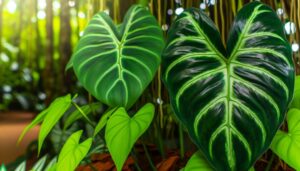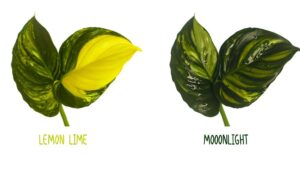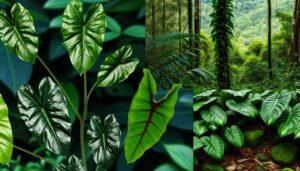Philodendron Brandi Vs Brandtianum: What’s the Difference?
Philodendron Brandi and Philodendron Brandtianum, originating from South America’s tropical rainforests, exhibit distinctive features. Brandi features narrow, elongated leaves with prominent silver variegation on young foliage, while Brandtianum presents broader, robust leaves with symmetrical silver-gray mottling.
Brandi’s climbing habit relies on aerial roots for support, whereas Brandtianum exhibits a trailing growth pattern. Both prefer bright, indirect light and high humidity, with well-draining, organic-rich soil.
Effective propagation includes techniques like stem cuttings and air layering. Understanding these unique traits and care requirements is essential for best growth and health in various environments.
Discover their specific differences and care nuances further.
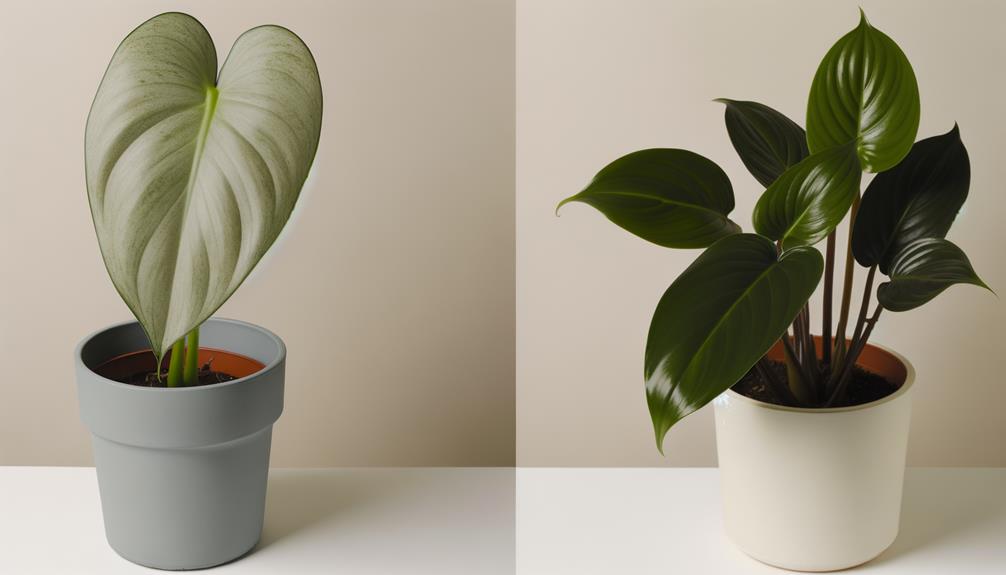
Comparison of Philodendron Brandi and Philodendron Brandtianum
| Characteristic | Philodendron Brandi | Philodendron Brandtianum |
|---|---|---|
| Common Name | Silver Leaf Philodendron | Silver Leaf Philodendron |
| Scientific Name | Philodendron brandtianum | Philodendron brandtianum |
| Leaf Shape | Heart-shaped | Heart-shaped |
| Leaf Color | Olive green with silver mottling | Dark green with heavy silver markings |
| Growth Habit | Climbing | Climbing |
| Mature Size | Up to 10 feet in height | 4-5 feet as a houseplant, up to 15 feet outdoors |
| Native Region | South America (Colombia, Brazil) | South America (Colombia, Brazil, Bolivia) |
| Care Requirements | Bright indirect light; moist soil | Bright indirect light; well-drained soil |
| Rarity | Less common | More widely available |
| Toxicity | Toxic to pets and humans | Toxic to pets and humans |
Origin and History
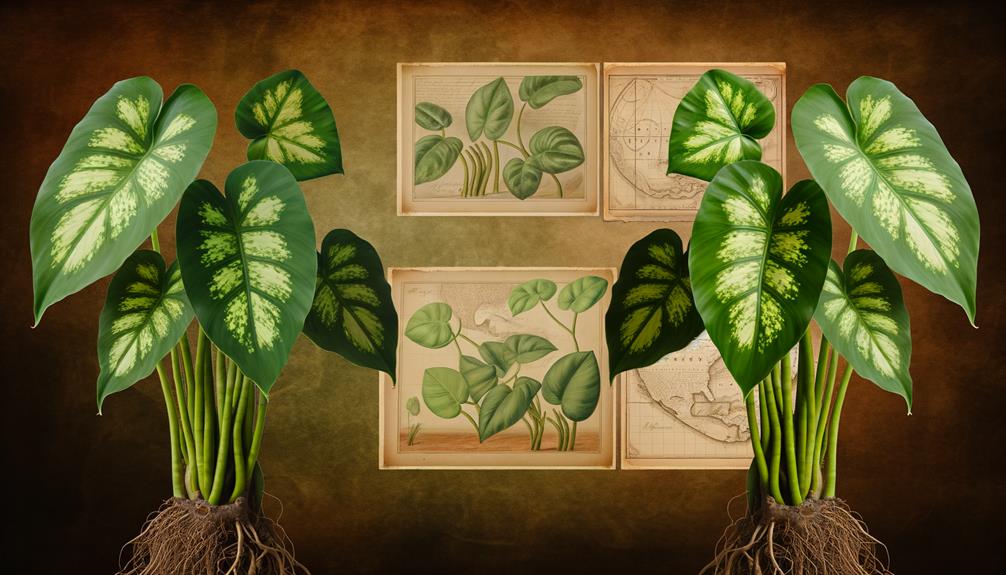
Tracing the origin and history of Philodendron Brandi and Philodendron Brandtianum reveals their roots in the tropical rainforests of South America, where they thrive in humid, shaded environments. These species belong to the Araceae family, a group notable for its diversity and adaptive strategies.
Philodendron Brandi, also known as Philodendron hederaceum var. oxycardium, and Philodendron Brandtianum have evolved to flourish under the dense canopy, benefiting from the constant moisture and diffused light. Historical botanical surveys indicate their presence in regions spanning from Brazil to Colombia.
Indigenous knowledge and early botanical exploration have documented their uses and ecological importance. These philodendrons have been subjects of horticultural interest, contributing significantly to our understanding of epiphytic and hemiepiphytic plant behaviors.
Leaf Shape and Size
Frequently displaying a heart-shaped morphology, the leaves of Philodendron Brandi and Philodendron Brandtianum exhibit significant variation in size, typically ranging from small to medium dimensions, with mature leaves measuring between 4 to 7 inches in length.
The lamina of Philodendron Brandi tends to be more elongated and slightly narrower, enhancing its delicate appearance. In contrast, Philodendron Brandtianum presents a broader and more robust leaf structure, contributing to its resilient nature.
Both species feature a prominent midrib and secondary veins that create a visually appealing venation pattern. Leaf margins are generally smooth, contributing to the overall symmetrical aesthetic.
These morphological characteristics are essential for taxonomic differentiation and understanding their adaptability in various environmental conditions.
Color and Pattern

In addition to their morphological distinctions, the coloration and pattern of the foliage in Philodendron Brandi and Philodendron Brandtianum further facilitate their identification and classification.
Philodendron Brandi exhibits a distinctive silver variegation on its leaves, characterized by irregular patches and streaks that contrast sharply with the dark green background. This silvery sheen is not uniformly distributed and often appears more pronounced on younger leaves.
Conversely, Philodendron Brandtianum features a more consistent and widespread silver-gray mottling across its foliage, giving it a more uniformly patterned appearance. The interspersed silver patterns of Brandtianum are typically more symmetrical and evenly spread, creating a striking visual effect.
These chromatic and patterning differences are pivotal for accurate taxonomic differentiation between the two species.
Growth Habit
The growth habit of Philodendron Brandi and Philodendron Brandtianum exhibits significant distinctions, particularly in their climbing versus trailing tendencies.
Philodendron Brandi typically demonstrates a vining or trailing growth pattern, whereas Philodendron Brandtianum is characterized by its climbing nature, often requiring support structures for best development.
Additionally, leaf morphology and light preferences further differentiate these species, with variations in leaf shape and sunlight requirements influencing their respective growth behaviors.
Climbing Vs. Trailing
Philodendron Brandi displays a climbing growth pattern, using aerial roots to anchor itself to vertical surfaces, while Brandtianum typically exhibits a trailing pattern, gracefully cascading from hanging baskets or elevated planters. This contrast in growth pattern reflects their ecological adaptations, influencing their care needs and aesthetic uses in horticulture.
| Characteristic | Philodendron Brandi | Brandtianum |
|---|---|---|
| Growth Pattern | Climbing | Trailing |
| Root Type | Aerial Roots | Soil Roots |
| Support Necessity | Requires vertical assistance | No assistance needed |
| Ideal Placement | Vertical structures | Hanging baskets, planters |
Understanding these growth patterns is essential for optimal placement and care, ensuring strong development and visual appeal.
Leaf Shape Differences
Distinct growth patterns are complemented by notable differences in leaf morphology between Philodendron Brandi and Brandtianum, offering a fascinating study in their adaptive traits and aesthetic variations.
Philodendron Brandi exhibits ovate leaves with a subtle, heart-like shape, characterized by prominent silver variegation and a smooth texture.
In contrast, Philodendron Brandtianum features elongated, lanceolate leaves with more pronounced, undulating margins and a distinct, matte finish.
The venation patterns also differ; Brandi’s leaves display a more reticulate network, whereas Brandtianum’s foliage showcases parallel venation.
These morphological distinctions not only enhance their ornamental appeal but also suggest divergent evolutionary adaptations to their native habitats, providing valuable insights into their respective ecological niches.
Light Preferences
Ideal light conditions for growth reveal significant discrepancies between Philodendron Brandi and Brandtianum, with each species displaying unique adaptations to their native light environments.
Philodendron Brandi, indigenous to tropical rainforests, flourishes in low to moderate indirect light, imitating the dappled sunlight filtered through the canopy. Excessive light can lead to leaf scorching.
On the other hand, Philodendron Brandtianum, also hailing from rainforests, prefers bright, indirect light but can withstand lower light levels. This species demonstrates a more flexible light tolerance, improving its growth pattern.
Research indicates that maintaining the best light conditions for each species ensures robust growth and foliage coloration. Understanding these preferences is essential for horticulturists aiming to replicate natural environments, thereby fostering healthy development and preventing photodamage.
Care Requirements
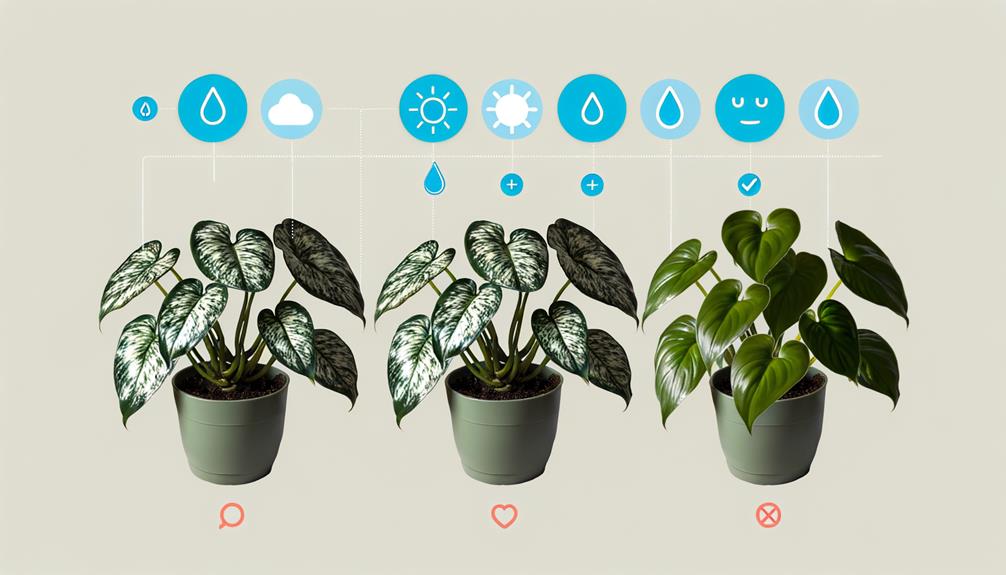
Ensuring best growth for Philodendron brandi and Philodendron brandtianum necessitates understanding their specific care requirements, including light, water, humidity, and soil preferences.
Both species thrive in indirect, bright light but can tolerate lower light conditions. Optimal watering involves maintaining consistently moist soil without waterlogging, as excessive moisture can lead to root rot.
Humidity levels of 60-80% are best, though they can adapt to lower levels with adequate care. Well-draining, aerated soil, rich in organic matter, is essential for root health; a mix of peat, perlite, and orchid bark is recommended.
Regularly wiping leaves helps maintain photosynthetic efficiency and prevents dust accumulation, ensuring robust growth and vibrant foliage. Understanding these factors is crucial for fostering healthy plants.
Common Pests and Diseases
Common pests and diseases affecting Philodendron brandi and Philodendron brandtianum include spider mites, aphids, mealybugs, and fungal infections, which can severely impact plant health if not promptly addressed.
Spider mites (Tetranychidae) cause stippling and leaf discoloration, while aphids (Aphidoidea) excrete honeydew that fosters sooty mold growth. Mealybugs (Pseudococcidae) create cotton-like masses, disrupting nutrient uptake. Fungal infections, such as root rot (Pythium spp.), result from overwatering or poor drainage, manifesting as blackened, mushy roots and wilting foliage.
Implementing integrated pest management (IPM) strategies, including regular inspections, biological controls like predatory insects, and maintaining best humidity levels, can mitigate these issues. Fungicides and insecticidal soaps may also be employed for severe infestations.
Prompt intervention is essential to preserve plant vigor and aesthetics.
Propagation Methods
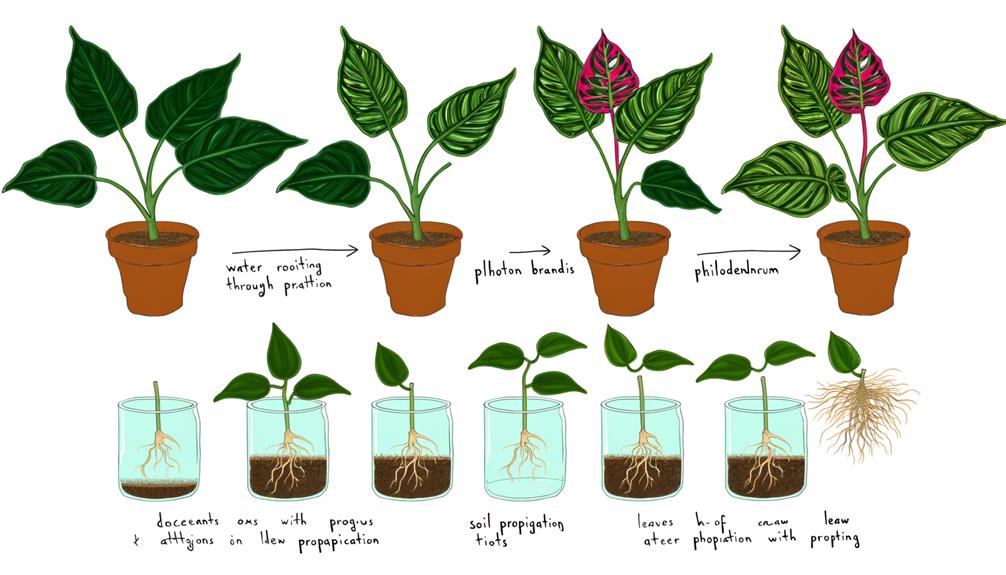
Effective management of pests and diseases lays the groundwork for successful propagation of Philodendron brandi and Philodendron brandtianum. This can be achieved through techniques such as stem cuttings, air layering, and division.
Stem cuttings involve excising a healthy segment of the plant, ensuring it has at least one node, and placing it in a well-draining medium to root. Air layering requires wounding a section of the stem, applying rooting hormone, and wrapping it in moist sphagnum moss until roots develop.
Division entails carefully separating the plant at the root system, ensuring each section contains sufficient roots and foliage. Research indicates that maintaining ideal humidity and temperature accelerates root development in these propagation methods.
Conclusion
To sum up, the comparative analysis of Philodendron brandi and Philodendron brandtianum unveils distinct differences in origin, leaf morphology, pigmentation, growth patterns, and care requirements. These disparities, though subtle, underscore the botanical diversity within the Philodendron genus.
Understanding these variances aids in optimized horticultural practices and targeted pest management strategies. Ultimately, these insights contribute to the broader field of botany, offering a nuanced appreciation of plant physiology and cultivation.
Indeed, knowledge is the seed from which expertise blossoms.


